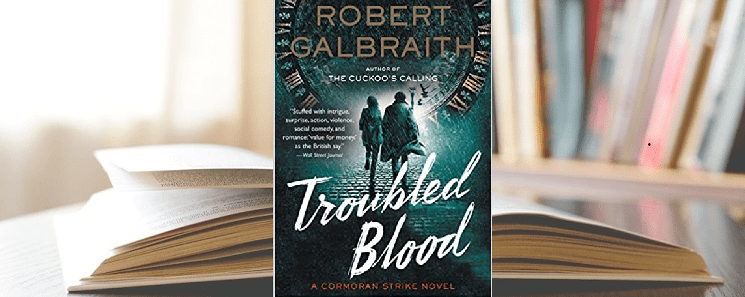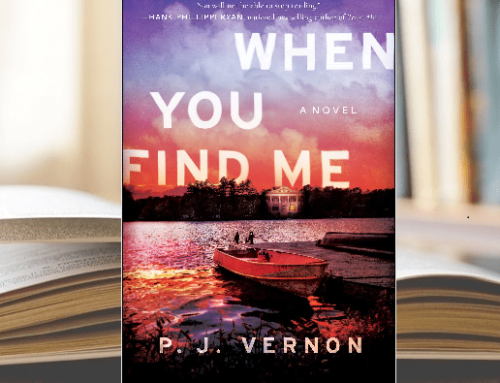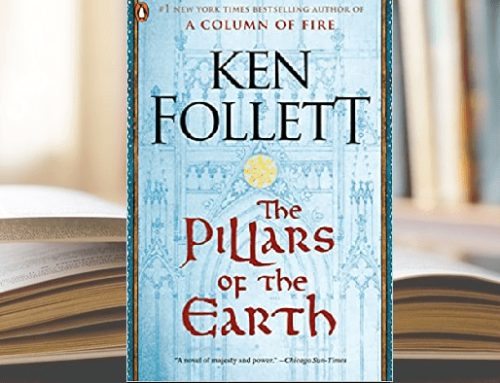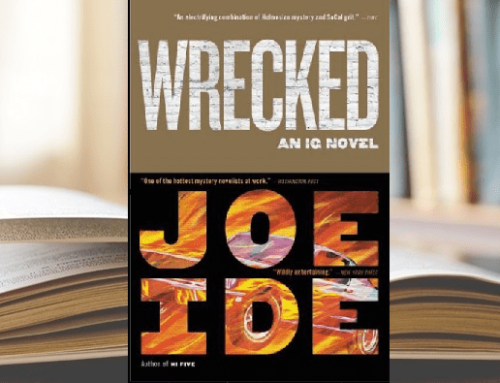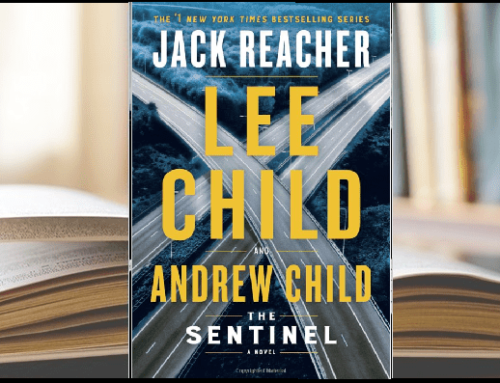[by Ross Browne]
If you’re a fan of JK Rowling writing as Robert Galbraith, you’re probably well aware how much longer her latest release is than the other four books in the series.
My own first reaction to the size of the hefty tome—darn near 1,000 pages in hardcover—was mostly: Terrific! More of a good thing to look forward to.
But I must confess to some trepidation as well. For me, one of the appeals of the mystery genre is that its stories tend to be fairly compact. The best are often told with a good deal more economy than is evident in a book that from a distance looks more like a James Clavell epic than a Raymond Chandler or Agatha Christie classic. Most contemporary private eye mysteries are longer than those much-beloved Marlowe or Marple stories of yesteryear, falling somewhere within the 70–85,000-word range. Troubled Blood is surely more than twice that.
I have zero interest in questioning or criticizing the decision to go longer and deeper in this title than others in the series. Rowling writing as Galbraith won me over to Cormoran Strike and Robin Ellacott years ago, and I’ll happily follow these two anywhere, no matter how long the journey. But I was very curious about why Troubled Blood is as long as it is and how it would, as a result of its length, differ from others in the series. And now that I’ve read it, I’m fascinated by the architecture of this unusual but entertaining mystery—and what people who aspire to write in the genre can learn from it.
I’m not surprised that some of Galbraith’s fans are not happy with this book, nor that some of what I consider to be assets to the experience of the read count as liabilities in the eyes of others. But I liked the novel a lot. And I mean what I say in the title: this is a book that rewards patience.
There’s a guy I like on Twitter whose automated tweets on writing often cycle to one about learning the rules of writing and then breaking them like a pro. On one hand, Galbraith has done just that in Troubled Blood. She’s written a book that plainly and quite deliberately (or so I’m guessing, anyway) goes directly against the grain of several time-honored mystery plotting conventions. But not without expert use of some of the best tools that belong in any mystery writer’s toolbox.
I’ll start with the former, with a decided nod of admiration toward the end result, even if we wouldn’t advise taking these approaches if you’re new to writing in the genre.
Limited Consequence of Failure
The drama of a good mystery is often fueled by the stakes of the investigation and the looming consequence of failure if the perpetrator isn’t caught and brought to justice. In the case of repeat offenders—serial killers, for instance—the consequences of failure are dramatic by definition because the longer the killer remains at large, the more people will die. In cases of isolated one-off crimes where there’s no threat of continued violence, the drama often surrounds a more foundational desire for justice—for good to triumph over evil and for the perpetrator to pay for his or her crimes. In either case, there’s usually a clearly defined payoff for readers should the protagonist(s) prevail and possibly tragic consequences should they fail.
Troubled Blood is a cold-case mystery, however, based on a doctor who disappeared over 30 years ago and probably died at the hands of a sadistic serial killer now serving life in the pokey. The desire to uncover the truth about what happened to Dr. Margot Bamborough may still be keenly felt by characters and readers alike, but it’s more distant and cerebral somehow because the crime happened so long ago.
In the hands of a lesser writer, the lack of urgency might prove more problematic than it does in Troubled Blood, especially since two of the most likely suspects are both already incarcerated, one literally and one more figuratively. So there’s simply not much anyone can do to make life worse for them, if one of them is in fact guilty. And Gailbraith seems very content to let readers assume that Margot is long dead and build the intrigue of the plot around how she died (and who killed her) rather than if she died. This is a choice I can respect, even if it saps some potential suspense from the story.
Galbraith does spend some time with Bamborough’s daughter and the grief over what happened to her mother, her need to understand and to have some kind of closure, after decades of not knowing. This is quite convincing. But the effect of this doesn’t become whole until the end, which spotlights her expression of how meaningful it was to learn what happened.
Beyond that, it’s really the strange, puzzling nature of the case itself and the impact of what went wrong in the initial investigation that drove my interest in seeing Cormoran and Robin succeed. There’s less pressure for immediate resolution than in, say, Career of Evil (which is my hands-down favorite in the series.)
No Ticking Clock
A “ticking clock” device is often used in crime fiction to tighten the screws on the protagonist(s) and help the story move at a good pace. A ticking clock incentivizes (if not demands) a quick resolution because something terrible will happen if a perpetrator isn’t caught soon. This helps create urgency, enhance pacing, and cultivate suspense.
In Troubled Blood, Galbraith takes the surprising step of having Bamborough’s daughter give Cormoran and Robin a full year to solve the case. This, coupled with the other factors I mentioned above, allows the book to unfold at an unusually unhurried pace. But Galbraith mines gold from the relative lack of pressure, and that’s part of what I find so interesting about the book.
No Protagonist in Jeopardy
Many mysteries derive some of their suspense from at least one “good guy” (no gender exclusion intended) in the story being in some kind of dramatic danger or jeopardy. This can be rooted in the dangerous work of chasing criminals or threats of retribution if the investigators don’t back off. Or—in the case of serial killer novels—the likelihood that others will die.
Investigators in mysteries often find themselves in vulnerable situations where their own safety is threatened in a given moment. Trouble Blood nips gently at this, but only fleetingly. Cormoran and Robin are occasionally in danger, but this isn’t central to the experience of the novel for readers. There’s only one time I can recall when readers can be expected to actively worry for one of them. (And, in a clever twist, others when we realize we might have worried had we known what was actually going on.)
This isn’t to say that there aren’t two frightening bad guys in the book. One is the aforementioned geriatric crime boss, whose kids are alive and well and known to be ruthless. The second is a serial killer already in jail for crimes having nothing to do with the book’s main plot. Galbraith does a fine job rendering both, but she holds Cormoran and Robin at bay from danger most of the time.
Wandering Plot Focus
I read dozens of mysteries every year, the vast majority of which focus primarily on one crime and one investigation. While there’s usually a subplot or two in the mix, most of the scenes in the book advance the main plot—the investigation central to the story—in one way or another.
No so in Troubled Blood. This book tells the story of not only the efforts to find out what happened to Margot Bamborough, but also several other cases the agency is involved with. We spend a good bit of time following surveillance and investigation of other matters that have no bearing on the Bamborough case.
It’s this last one that I think contributes most perplexingly to the novel’s unusual length. Try though I may, I can’t figure out why Galbraith decided to do it, though I did enjoy the tangents.
These other cases aren’t especially remarkable. And they’re far less dramatic in premise than the main plot. They do provide opportunities for drama and characterization, but they distract from the main plot.
What makes the book a success in my view isn’t rooted in what it doesn’t do but rather what it does. Galbraith’s choices with all the above allow the book to go to unexpected places that serve characterization and a series-spanning character arc in deeper ways than many mysteries do.
Fans of the series will be very familiar with the chemistry that has simmered between Comoran and Robin since book one. Many probably shared my exasperation with Robin trying to make things work with her near-total shit of a husband and Cormoran’s sometimes pigheaded way of dealing with his repressed attraction to Robin. Many probably held their breath, as I did, in that unforgettable moment at Robin’s wedding where for just a moment it looked like she and Cormoran might just…well…if you’ve read Lethal White, you know what I‘m talking about.
Troubled Blood sustains and develops this tension in both expected and unexpected ways. Galbraith continues to lavish attention to the conundrum at the heart of this series-spanning subplot. We see this powerful but subdued sort of yearning from both characters’ viewpoints and get firsthand views of how similar their feelings are for each other, their shared viewpoint on the reasons they must not to act on the impulse, and the sneaking suspicion of reciprocity.
We see how right these two might just be for each other, at least in some ways. We feel their frustration as their mutual desire clashes with the tenuous resolve not to give in for fear it might ruin a friendship and a business that’s meaningful to them both. And while physical attraction is part of this, there’s something deeper and more powerful driving it. I can’t recall a mystery that has made me want two characters to get together so badly while at the same time hoping like crazy that they won’t. It’s an interesting experience for readers, and I think all the attention this gets in Troubled Blood is ink well spent, even if it slows the pace.
But this isn’t the only character-based subplot. We also get the stories of the effort to reconcile Cormoran and his estranged father, Cormoran’s experience of the decline and death of the only nurturing mother figure he has ever known, the final chapter in the dissolution of Robin’s horrible marriage, and her own struggles to be treated as an equal within the agency where she’s now partner. There’s delicious complexity (and interconnectedness) in all these subplots, and I think some of the emotional climaxes in the book are rooted more in subplot than plot.
This isn’t to say that the Bamborough investigation isn’t interesting or exciting. It is quite fascinating, actually, in part because of the difficulties in investigating something that happened such a long time ago and in Cormoran and Robin having to walk in footsteps laid by the detective who went quite mad during the first investigation of Bamborough’s disappearance (talk about an unusual plot wrinkle!)—and finally, because of where the book goes along the way.
Galbraith’s immense skill with characterization is for me what makes this book and this series so special. You will meet characters in this novel unlike any you’ve met before and get to know them well. You may be mortified with the heroes of the story at their worst or begrudgingly admiring of the miscreants at their best.
Some you’ll probably love and rally for despite their flaws. Some you may pity. Some you’ll laugh at, and some may repulse you. But twenty gets you ten that every single one will engage you and take you to someplace new. And at least one will probably surprise the daylights out of you.
Galbraith blows so much life into the personality, temperament, eccentricities, and backstories of her major and minor characters—something that would be very hard to do in a mystery more concerned with pacing (or in a narrative more dependent on high-pressure interrogation-style dialogue more common to police procedurals). On this note, one risky move that I love is how often Cormoran and Robin let interviewees tell their stories at great length with only minimal interruption. This is something we often advise against, but it works well with what I can glean of the author’s intentions in this book.
But not everything Galbraith does flies in the face of convention in the genre of mystery. Here are a handful of examples that might be useful to others writing in the genre.
Red Herrings
Good mysteries nearly always try to mislead readers as to the identity of the killer, usually with seemingly more likely candidates who have enough means, motive, and opportunity to be credible suspects. There are plenty in Troubled Blood, and Galbraith does a fine job making them convincing.
Clues, Clues, Clues
You really can’t have a good mystery without a well-thought-out path of clues for readers to follow and make sense of along with the investigator(s). This is especially important for readers who like to sleuth along with the detectives and try to figure out whodunnit before the book itself reveals the truth.
Galbraith does a fine job with this in Troubled Blood. Some clues point in the right direction and some don’t (as should be the case). But all the major breaks in the case are well supported by clues along the way, and the leaps of deduction made in response are reasonable and convincing.
Lively, Entertaining Dialogue
Mystery is one of the most dialogue-driven genres of fiction I can think of. In many cases, the dialogue is the action in the story, being the main vehicle for advancing plot—bringing developments to surface and giving readers the opportunity to decide who’s telling the truth and who’s not.
Galbraith’s approach to dialogue is unusual in some respects, in part due to the aforementioned comfort she has in allowing her investigators to shut the heck up and just listen. She tends to deal more in interviews than interrogations, since her protagonists are private eyes and thus have no lawful authority to demand anything from the people they talk to.
While there might be less bullying and badgering than one sees in hostile police interrogations, there’s still plenty of tension and dramatic ebb and flow in the dialogue. And because these characters have such well-defined and distinct voices, there’s rich pleasure for readers in the experience of their words and stories.
Satisfying Denouement
I could go on and on about all Galbraith gets right in this novel, but given its unusual length, I’ll focus on the all-important matter of what’s in it for readers at the end.
The ending of this book has nearly everything a reader could want. From the surprising and clever way in which the identity of the guilty is revealed, to the life-changing impact of the truth on those most affected by it, to a subtle but welcome shift in relationship dynamics between Cormoran and Robin, the ending just satisfies on so many levels. It’s a wonderful ending that I believe will leave most readers hungry for the next book.

